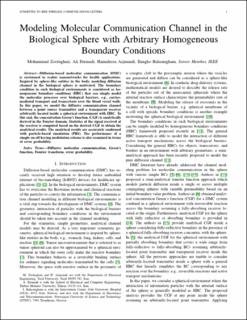| dc.contributor.author | Zoofaghari, Mohammad | |
| dc.contributor.author | Etamadi, Ali | |
| dc.contributor.author | Arjmandi, Hamidreza | |
| dc.contributor.author | Balasingham, Ilangko Sellappah | |
| dc.date.accessioned | 2022-10-07T06:38:36Z | |
| dc.date.available | 2022-10-07T06:38:36Z | |
| dc.date.created | 2022-01-23T12:45:13Z | |
| dc.date.issued | 2021 | |
| dc.identifier.citation | IEEE Wireless Communications Letters. 2021, 10 (12), 2786-2790. | en_US |
| dc.identifier.issn | 2162-2337 | |
| dc.identifier.uri | https://hdl.handle.net/11250/3024392 | |
| dc.description.abstract | Diffusion-based molecular communication (DMC) is envisioned to realize nanonetworks for health applications. Inspired by sphere-like entities in the body, modeling diffusion channel in the biological sphere is motivated. The boundary condition in such biological environments is considered as homogeneous boundary conditions (HBC) that can simply model the molecular processes over biological barriers, e.g., carrier-mediated transport and transcytosis over the blood vessel walls. In this letter, we model the diffusive communication channel between a point source transmitter and a transparent receiver arbitrarily located inside a spherical environment with HBC. To this end, the concentration Green’s function (CGF) is analytically derived in the Fourier domain. Statistics of the signal received at the receiver is computed based on the derived CGF to obtain the analytical results. The analytical results are accurately confirmed with particle-based simulation (PBS). The performance of a simple on-off keying modulation scheme is also examined in terms of error probability. | en_US |
| dc.language.iso | eng | en_US |
| dc.publisher | Institute of Electrical and Electronics Engineers (IEEE) | en_US |
| dc.title | Modeling Molecular Communication Channel in the Biological Sphere With Arbitrary Homogeneous Boundary Conditions | en_US |
| dc.type | Peer reviewed | en_US |
| dc.type | Journal article | en_US |
| dc.description.version | acceptedVersion | en_US |
| dc.rights.holder | © IEEE. Personal use of this material is permitted. Permission from IEEE must be obtained for all other uses, in any current or future media, including reprinting/republishing this material for advertising or promotional purposes, creating new collective works, for resale or redistribution to servers or lists, or reuse of any copyrighted component of this work in other works. | en_US |
| dc.source.pagenumber | 2786-2790 | en_US |
| dc.source.volume | 10 | en_US |
| dc.source.journal | IEEE Wireless Communications Letters | en_US |
| dc.source.issue | 12 | en_US |
| dc.identifier.doi | 10.1109/LWC.2021.3117411 | |
| dc.identifier.cristin | 1988032 | |
| cristin.ispublished | true | |
| cristin.fulltext | preprint | |
| cristin.qualitycode | 1 | |
